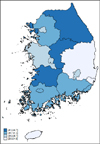Abstract
Purpose
This study examined the impact factors of cesarean section based on the ecological approach in Korea.
Methods
Population-based data (Korea Institute for Health and Social Affairs) were used from 2,849 delivery cases during 2003~2009. Data were analyzed using geographic statistics with STATA 10.0 and hierarchical logistic regression with SPSS/WIN 12.0.
Results
The range of cesarean section rate was 28.8~44.7% with geographic distribution. The proportion of mother's problem was increasing in choice of cesarean section. According to the ecological model, age of mother (OR=1.08), time of birth (OR=0.79), delivery in hospital (OR=1.83), delivery in clinic (OR=1.46), and education of mother (OR=2.61) had significant impact on cesarean section.
Figures and Tables
References
1. Ahn H.S. Cesarean section: We need a count measure. Health and Welfare Policy Forum. 2000. 6:32–33.
2. Bakker R., Steegers E.A.P., Biharie A.A., Mackenbach J.P., Hofman A., Jaddoe V.W.V. Explaining differences in birth outcomes in relation to maternal age: The generation R study. BJOG: An International Journal of Obstetrics and Gynaecology. 2011. 118(4):500–509.
3. Bronfenbrenner U. The Ecology of human development: Experiments by nature and design. 1979. Cambridge: Harvard University Press.
4. Bujold E., Hammoud A.O., Hendler I., Berman S., Blackwell S.C., Duperron L., et al. Trial of labor in patients with a previous cesarean section: Does maternal age influence the outcome? American Journal of Obstetrics and Gynecology. 2004. 190(4):1113–1118.
5. Cesaroni G., Forastiere F., Perucci C.A. Are cesarean deliveries more likely for poorly educated parents? A brief report from Italy. Birth. 2008. 35(3):241–244.
6. Chhabra P., Sharma A.K., Tupil K.A. Obstetric and neonatal outcomes in women who live in an urban resettlement area of Delhi, India: A cohort study. Journal of Obstetrics and Gynaecology Research. 2006. 32(6):567–573.
7. Chung J.J. Cesarean section and women's health. Gender Review. 2006. 2:42–48.
8. Chung J.J. Causes of increasing rate of C-section and desirable birth environment perceived by women with C-section. Korean Journal of Women's Health. 2008. 9(1):57–85.
9. Churchill H., Francome C. British midwive's views on rising cesarean section. British Journal of Midwifery. 2009. 17(12):774–778.
10. Collard T.D., Diallo H., Habinsky A., Hentschell C., Vezeau T.M. Elective cesarean section: Why women choose it and what nurses need to know. Nursing for Women's Health. 2008. 12(6):480–498.
11. Evaluation of appropriateness of cesarean section rate. Health Insurance Review & Assessment Service. 2011. Retrieved February 13, 2011. from
http://www.hira.or.kr.
12. Hwang J.Y. A clinical study of pregnancy and delivery in pregnant women 35 year and older. Dongguk Journal of Medicine. 2003. 10(2):298–306.
13. Hyunh T., Alderson M. Concept analysis of human ecology. Nursing Forum. 2009. 44(2):115–128.
14. Jo Y.B. Impact of hospital market competition on cesarean section rate. 2010. Seoul: Korea University;Unpublished master's thesis.
15. Kim Y.M., Ko S.K. Factors determining cesarean section frequency rates of the OBGY clinics in metropolitan area. Korean Journal of Women Health Nursing. 2002. 8(3):389–401.
16. Korean health and welfare information. Korea Institute for Health and Social Affairs. 2011. Retrieved February 11, 2011. from
http://www.kihasa.re.kr.
17. Census of population trends. Korea Statistical Information Service. 2011. Retrieved February 11, 2011. from
http://www.kosis.kr.
18. Lee K.H., Lee Y.S., Ko M.S., Kim H.J., Park N.J., Park Y.J., et al. Maternity & women's health nursing. 2010. 2nd ed.Seoul: Hyunmoonsa.
19. Lee K.Y. Suggestion for reducing cesarean section rate. The Korean Association of Obstetricians and Gynecologists Symposium. 2003. 89:74–79.
20. Logsdon M.C., Gennaro S. Bioecological model for guiding social support research and interventions with pregnant adolescents. Issues in Mental Health Nursing. 2005. 26(3):327–339.
21. McLeroy K.R., Bibeau D., Steckler A., Glanz K. An ecological perspective on health promotion program. Health Education Quarterly. 1988. 15:351–377.
22. Menacker F., MacDorman M.F., Declercq E. Neonatal mortality risk for repeat cesarean compared to vaginal birth after cesarean (VBAC) deliveries in the United States, 1998-2002 birth cohorts. Maternal and Child Health Journal. 2010. 14(2):147–154.
23. Novilla M.L., Barnes M.D., De La Cruz N.G., Williams P.N. Public health perspectives on the family: An ecological approach to promoting health in the family and community. Family & Community Health. 2006. 29(1):28–42.
24. Seo K. Actual condition and trend of cesarean section rate. The Korean Association of Obstetricians and Gynecologists Symposium. 2003. 89:59–63.
25. Tschudin S., Alder J., Hendriksen S., Bitzer J., Popp K.A., Zanetti R., et al. Pregnant women's perception of cesarean section on demand. Journal of Perinatal Medicine. 2009. 37(3):251–256.
26. Vecino-Ortiz A.I., Bardey D., Castano-Yepes R. Small-area variation in health care affecting the choice of cesarean delivery: The case of a Colombian health insurer. Serie Documentos de Trabajo. 2009. 73(1):1–23.
27. Wilcox P. An ecological approach to understanding youth smoking trajectories: Problems and prospects. Addiction. 2003. 98:Suppl 1. 57–77.
28. Appropriate technology for birth. Lancet. 1985. 2:436–437.
29. Xirasagar S., Lin H.C., Liu T.C. Do group practices have lower caesarean rates than solo practice obstetric clinics? Health Policy and Planning. 2006. 21(4):319–325.




 ePub
ePub Citation
Citation Print
Print







 XML Download
XML Download